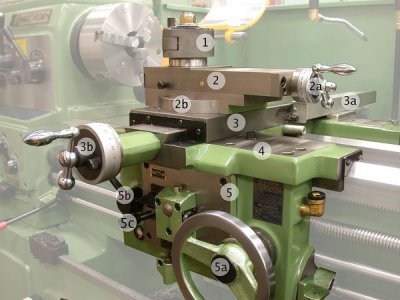[I'll be able to get back into the shop this week. Once I do, I'll start a new thread in this forum to post my progress on machining the replacement cross-slide using Andy's casting.]
Regarding the original question, I think most small (9", 10", 11") benchtop lathes had compound slides that were roughly the same size between South Bend, Logan, and Atlas (though the slot sizes were different as mentioned previously). Each vendor attaches the compounds to the cross-slide in very different ways. I believe SB uses a "circular dovetail" clamping mechanism of some sort, while Logan uses clamping bolts in a circular tee-slot. The dovetail design is probably slightly superior, but I've had no problems whatsoever with my Logan compound.
Andy's casting certainly fits my lathe just fine (the gross dimensions are shown at that link).
Andy does make
a different casting expressly for an Atlas lathe, but it's solely intended as a separate "boring table" rather than as a complete replacement of your existing cross-slide (that is, you aren't expected to mount your compound to it).
Regarding milling on a Logan: I've got a Palmgren milling attachment and before I acquired my mill I successfully milled a few simple parts, but man was it a pain. Amongst other problems, attaching the Palmgren
to the compound (rather than in place of the compound) just doesn't provide sufficient rigidity. The heavy vise/milling-attachment is just too top heavy that way. Tramming is a real headache, and my Palmgren just has a knurled knob for traversing in Y (up and down) — believe me, turning that knob gets old quick. I think some units have ball-handles for cranking in Y, which would be very welcome (if I end up using it again for anything, I'll likely replace the knurled knob with something better, but the vise handle limits the available space for a ball-crank).
Basically, the stock Logan cross-slide (on my 1941 Monkey Wards 11" Powr-Kraft lathe) just doesn't provide a good attachment point for the Palmgren milling attachment — you're forced to attach it to the compound itself.
I've no direct experience yet, but I'm convinced that a "boring table" (or longer, and squarer, replacement cross-slide) will provide a much more rigid attachment point for tooling and parts during milling/facing/boring operations. It's the difference between bolted-on legs and welded legs on a table — its surprising how much rigidity you lose with each bolted-together connection.
Even though I eventually threw in the towel and purchased a mill ("honest, honey, I
need just this one more machine") I suspect that some milling-style operations are still better suited to the lathe. Sometimes you just want to spin the part rather than the tool. As a hobbyist, I also really enjoy old-school ways of doing things (like using faceplates, turning between centers, using toolmaker's buttons to setup for precision boring, etc.). Such operations are far easier to accomplish with a "boring table" style cross-slide vs. the stock short slide which has few square surfaces.
For my summer projects, I purchased Andy's castings for the boring-table/cross-slide, rear-mount toolpost, and a "transfer block." I'm making good progress on the boring table, but haven't started the latter projects. I'm happy as the proverbial that these projects are exposing me to all sorts of new techniques (slot milling, scraping, etc.) and, even better, forcing me to build or purchase more tools! <laugh> I'm also pretty sure that once complete, I'll be able to do even more with my lathe than I could with only the stock cross-slide.
The beginning of the entire adventure for me was acquiring George H. Thomas's "
The Model Engineers Workshop Manual." As I started making a few tools from that book (the scriber, rule holder, and finger plate so far) I started lusting after a "boring table" type cross-slide to allow me to use some of the other projects from that book. It appears that Andy's castings are based on Mr. Thomas's designs (or at least are quite similar).
Regards,
--
Rex

